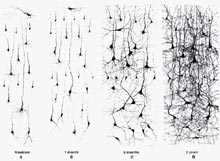The Secret Life of Lead
 | |
|
|
If you, like most of us, don’t work in a scientific field, chances are the only time research grabs your attention is when the results of a study make headlines. But that’s just one brief, albeit important point in the scientific process. Behind those results are years of hard work, false starts and moments of inspiration.
Living on Earth has begun a special project on cutting-edge science. Through it, we hope to reveal the steps leading up to important scientific discoveries. The first part of our series documents the secret life of lead.
![]()
![]()
For this special, Living on Earth follows a team of researchers at the University of Cincinnati and Cincinnati Children’s Hospital who have been trying to unravel the effects of childhood lead exposure. It’s a process that’s taken these scientists more than two decades, and it’s far from finished. Our story on emerging science doesn’t begin in a lab filled with people with white coats, but in a modest, tidy living room on the outskirts of Cincinnati.
 | |
|
|
Tony is a young man of color who was raised in an impoverished section of Cincinnati. Troubles dominate his life. He’s been unable to hold a job or a relationship and has had problems with the law.
Though it may be easy for some to assume that Tony's problems stem from his background, scientists have been working on a more basic theory – exposure to lead. Researchers believe effects of lead exposure may have been a significant factor in Tony's long-term behavior.
Tony is part of a 20-year study in his hometown of Cincinnati on the effects of lead on human development. Kim Dietrich, a neuropsychologist with the University of Cincinnati, heads up this long-term study. He says initially he believed race and income were key to some of the poor human outcomes linked to lead poisoning. But his research team has learned over the years that there is a larger association between childhood exposure to lead paint and patterns of delinquency and crime among the nearly 300 people studied since birth.
Scientists have been able to document damage to developing brains in
problems such as lower IQs, poor learning ability, increased impulsivity, and a lack of ability to pay attention or plan ahead. Most recently, scientists in Cincinnati and elsewhere are reporting that elevated childhood blood lead levels within this study group have led to a higher chance of these adolescents being involved in juvenile crime. Dietrich emphasizes that even though the hazards of lead paint are well known, lead continues to poison new generations around the country.
All About Lead
Lead poisoning is nothing new – overexposure to lead has sickened people since at least the days of the Roman Empire. Lead was ubiquitous in ancient Rome; it made up the pipes of the aqueducts, it was shaped into coins, cookware, and tableware, it was even used to enhance the flavor of food and mask the acidity of poor-quality wine. Lead poisoning affected people of every social class, from laborers in the mines to the members of the ruling class, who intentionally added lead to sweeten the flavor of their food and drink. Some historians today suggest the effects of lead poisoning – sterility, high infant mortality, brain damage – played a prominent role in the fall of the Roman Empire.
Much of our understanding of lead poisoning today began with Dr. Alice Hamilton, a physician and social activist in the early 1900s. After uncovering hundreds of cases of severe lead poisoning among lead industry employees in Illinois, she studied how the human body metabolizes it. Perhaps her most important finding was that the body doesn’t fully metabolize lead. Rather than breaking down to be eliminated as a waste product, lead, she found, accumulates in the body’s bones and tissues.
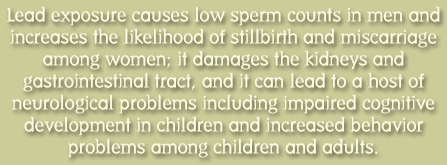
Today, scientists, physicians and public health officials know that lead affects nearly every system in the human body. Lead exposure causes low sperm counts in men and increases the likelihood of stillbirth and miscarriage among women; it damages the kidneys and gastrointestinal tract, and it can lead to a host of neurological problems including impaired cognitive development in children and increased behavior problems among children and adults.
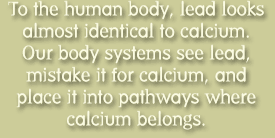 Lead belongs to a class of compounds known as heavy metals. These include about 40 elements occurring naturally in the Earth’s crust, such as cadmium, mercury, titanium, copper and iron. The human body relies on some of these metals in minute quantities: copper, for instance, plays a role in moderating enzyme function and in controlling blood pressure; and iron helps ferry oxygen throughout the body. Lead, however, is what scientists call xenobiotic – a foreign substance with no useful role in human physiology, toxic even in minute quantities.
Lead belongs to a class of compounds known as heavy metals. These include about 40 elements occurring naturally in the Earth’s crust, such as cadmium, mercury, titanium, copper and iron. The human body relies on some of these metals in minute quantities: copper, for instance, plays a role in moderating enzyme function and in controlling blood pressure; and iron helps ferry oxygen throughout the body. Lead, however, is what scientists call xenobiotic – a foreign substance with no useful role in human physiology, toxic even in minute quantities.
| Ingestion of lead from paint chips isn’t the whole story. In some communities, children are poisoned by folk remedies their parents give them to treat ailments such as stomachaches and fever. Some common household remedies that contain lead: Hmong community: Asian Indian community: Arab American community: Reprinted with permission from the California Department of Health Services and the Childhood Lead Poisoning Prevention Branch. | |
| Related Links | |
 Lead and Violent Crime – Common sources of lead poisoning other than paint |
Despite lead’s toxicity, the human body rapidly absorbs it. Once inhaled or ingested, it binds to red blood cells and travels throughout the body. Much of that lead follows the same pathways calcium takes – first to the bones and teeth, then to soft tissues including the brain, kidneys, and reproductive system.
To the human body, lead looks almost identical to calcium. Our body systems see lead, mistake it for calcium, and place it into pathways where calcium belongs. Some doctors think this replacement of lead for calcium explains many of the problems associated with lead poisoning. Calcium plays an essential role in cellular signaling systems – it triggers the release of neurotransmitters in the brain and it also plays a role in regulating gene function. Anything that interferes with calcium’s intended role quickly disrupts those systems. In the brain, for example, neurotransmitters deliver signals from one cell to the next. Calcium regulates the correct firing of these neurotransmitters. When lead finds its way to the brain, it displaces calcium and interferes with the regulation of neurotransmitter release. This can be an especially severe problem among young children whose brains are still developing. By interfering with normal neurotransmitter release, lead can disrupt the brain’s ability to build efficient networks, which could interfere with cognitive development.
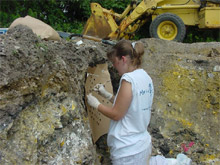 | |
|
|
Lead Soil Abatement
![]()
The scene in the photograph is from a contaminated Department of Transportation site in Indiana. Forty years ago, the disposal techniques for road paint resulted in the formation of a bright yellow paint layer in the soil, and also soil contamination with toluene, a toxic organic solvent. The paint pigments contain the toxic heavy metals lead and chromium. That paint has not moved, dissolved, or washed away in four decades. Today, Purdue University researchers studying the site have found a thriving population of microbes in this highly contaminated soil.
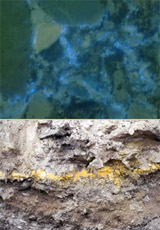 | |
|
|
They have found that some microbes are actively growing at very high metal concentrations. In addition, some of them can be cultivated in the laboratory, and grow at lead concentrations ten times higher than levels that typically kill bacteria. While the scientists haven’t determined the exact mechanisms for microbial lead resistance, it appears that some microbes can pump lead out of their cells, preventing it from building up to toxic levels. Other microbes don’t let lead into their cells in the first place. Instead, they produce a molecule outside their cells, which sops up lead in the environment and reduces its “bioavailability.” Still other microbes can bind lead to other molecules inside the cell, turning the lead into an insoluble precipitate which also eliminates its bioavailability. These microbes keep the lead inside their bodies permanently. Some scientists even suggest that by sequestering environmental lead, these microbes are acting altruistically, leaving the environment more hospitable for the rest of the microbial community.
(source: Allan Konopka, Purdue University)
| Audio Features | |
| The Secret Life of Lead, part 1 | |
| The Secret Life of Lead, part 2 | |
| The Secret Life of Lead, part 3 | |
| The Secret Life of Lead (full hour show) | |
| Related Links | |
| – Alliance to End Childhood Lead Poisoning | |
Back to the series and features homepage
Living on Earth wants to hear from you!
Living on Earth
62 Calef Highway, Suite 212
Lee, NH 03861
Telephone: 617-287-4121
E-mail: comments@loe.org
Newsletter [Click here]
Donate to Living on Earth!
Living on Earth is an independent media program and relies entirely on contributions from listeners and institutions supporting public service. Please donate now to preserve an independent environmental voice.
NewsletterLiving on Earth offers a weekly delivery of the show's rundown to your mailbox. Sign up for our newsletter today!
 Sailors For The Sea: Be the change you want to sea.
Sailors For The Sea: Be the change you want to sea.
 The Grantham Foundation for the Protection of the Environment: Committed to protecting and improving the health of the global environment.
The Grantham Foundation for the Protection of the Environment: Committed to protecting and improving the health of the global environment.
 Contribute to Living on Earth and receive, as our gift to you, an archival print of one of Mark Seth Lender's extraordinary wildlife photographs. Follow the link to see Mark's current collection of photographs.
Contribute to Living on Earth and receive, as our gift to you, an archival print of one of Mark Seth Lender's extraordinary wildlife photographs. Follow the link to see Mark's current collection of photographs.
 Buy a signed copy of Mark Seth Lender's book Smeagull the Seagull & support Living on Earth
Buy a signed copy of Mark Seth Lender's book Smeagull the Seagull & support Living on Earth

